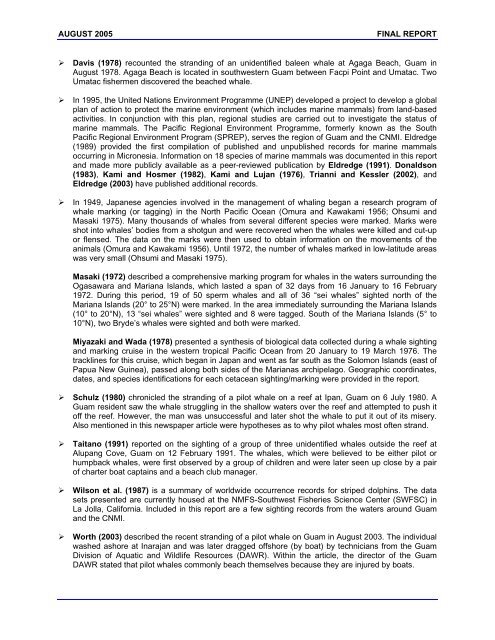Marine Resources Assessment for the Marianas Operating ... - SPREP
Marine Resources Assessment for the Marianas Operating ... - SPREP
Marine Resources Assessment for the Marianas Operating ... - SPREP
You also want an ePaper? Increase the reach of your titles
YUMPU automatically turns print PDFs into web optimized ePapers that Google loves.
AUGUST 2005 FINAL REPORT<br />
Davis (1978) recounted <strong>the</strong> stranding of an unidentified baleen whale at Agaga Beach, Guam in<br />
August 1978. Agaga Beach is located in southwestern Guam between Facpi Point and Umatac. Two<br />
Umatac fishermen discovered <strong>the</strong> beached whale.<br />
In 1995, <strong>the</strong> United Nations Environment Programme (UNEP) developed a project to develop a global<br />
plan of action to protect <strong>the</strong> marine environment (which includes marine mammals) from land-based<br />
activities. In conjunction with this plan, regional studies are carried out to investigate <strong>the</strong> status of<br />
marine mammals. The Pacific Regional Environment Programme, <strong>for</strong>merly known as <strong>the</strong> South<br />
Pacific Regional Environment Program (<strong>SPREP</strong>), serves <strong>the</strong> region of Guam and <strong>the</strong> CNMI. Eldredge<br />
(1989) provided <strong>the</strong> first compilation of published and unpublished records <strong>for</strong> marine mammals<br />
occurring in Micronesia. In<strong>for</strong>mation on 18 species of marine mammals was documented in this report<br />
and made more publicly available as a peer-reviewed publication by Eldredge (1991). Donaldson<br />
(1983), Kami and Hosmer (1982), Kami and Lujan (1976), Trianni and Kessler (2002), and<br />
Eldredge (2003) have published additional records.<br />
In 1949, Japanese agencies involved in <strong>the</strong> management of whaling began a research program of<br />
whale marking (or tagging) in <strong>the</strong> North Pacific Ocean (Omura and Kawakami 1956; Ohsumi and<br />
Masaki 1975). Many thousands of whales from several different species were marked. Marks were<br />
shot into whales’ bodies from a shotgun and were recovered when <strong>the</strong> whales were killed and cut-up<br />
or flensed. The data on <strong>the</strong> marks were <strong>the</strong>n used to obtain in<strong>for</strong>mation on <strong>the</strong> movements of <strong>the</strong><br />
animals (Omura and Kawakami 1956). Until 1972, <strong>the</strong> number of whales marked in low-latitude areas<br />
was very small (Ohsumi and Masaki 1975).<br />
Masaki (1972) described a comprehensive marking program <strong>for</strong> whales in <strong>the</strong> waters surrounding <strong>the</strong><br />
Ogasawara and Mariana Islands, which lasted a span of 32 days from 16 January to 16 February<br />
1972. During this period, 19 of 50 sperm whales and all of 36 “sei whales” sighted north of <strong>the</strong><br />
Mariana Islands (20° to 25°N) were marked. In <strong>the</strong> area immediately surrounding <strong>the</strong> Mariana Islands<br />
(10° to 20°N), 13 “sei whales” were sighted and 8 were tagged. South of <strong>the</strong> Mariana Islands (5° to<br />
10°N), two Bryde’s whales were sighted and both were marked.<br />
Miyazaki and Wada (1978) presented a syn<strong>the</strong>sis of biological data collected during a whale sighting<br />
and marking cruise in <strong>the</strong> western tropical Pacific Ocean from 20 January to 19 March 1976. The<br />
tracklines <strong>for</strong> this cruise, which began in Japan and went as far south as <strong>the</strong> Solomon Islands (east of<br />
Papua New Guinea), passed along both sides of <strong>the</strong> <strong>Marianas</strong> archipelago. Geographic coordinates,<br />
dates, and species identifications <strong>for</strong> each cetacean sighting/marking were provided in <strong>the</strong> report.<br />
Schulz (1980) chronicled <strong>the</strong> stranding of a pilot whale on a reef at Ipan, Guam on 6 July 1980. A<br />
Guam resident saw <strong>the</strong> whale struggling in <strong>the</strong> shallow waters over <strong>the</strong> reef and attempted to push it<br />
off <strong>the</strong> reef. However, <strong>the</strong> man was unsuccessful and later shot <strong>the</strong> whale to put it out of its misery.<br />
Also mentioned in this newspaper article were hypo<strong>the</strong>ses as to why pilot whales most often strand.<br />
Taitano (1991) reported on <strong>the</strong> sighting of a group of three unidentified whales outside <strong>the</strong> reef at<br />
Alupang Cove, Guam on 12 February 1991. The whales, which were believed to be ei<strong>the</strong>r pilot or<br />
humpback whales, were first observed by a group of children and were later seen up close by a pair<br />
of charter boat captains and a beach club manager.<br />
Wilson et al. (1987) is a summary of worldwide occurrence records <strong>for</strong> striped dolphins. The data<br />
sets presented are currently housed at <strong>the</strong> NMFS-Southwest Fisheries Science Center (SWFSC) in<br />
La Jolla, Cali<strong>for</strong>nia. Included in this report are a few sighting records from <strong>the</strong> waters around Guam<br />
and <strong>the</strong> CNMI.<br />
Worth (2003) described <strong>the</strong> recent stranding of a pilot whale on Guam in August 2003. The individual<br />
washed ashore at Inarajan and was later dragged offshore (by boat) by technicians from <strong>the</strong> Guam<br />
Division of Aquatic and Wildlife <strong>Resources</strong> (DAWR). Within <strong>the</strong> article, <strong>the</strong> director of <strong>the</strong> Guam<br />
DAWR stated that pilot whales commonly beach <strong>the</strong>mselves because <strong>the</strong>y are injured by boats.
















